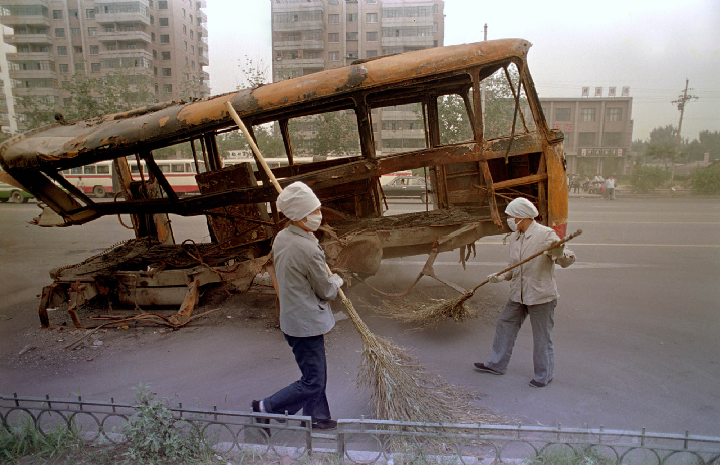WATCH ABOVE: Wednesday marks the 25th anniversary of the deadly Chinese government crackdown on protesters in Tiananmen Square. The “Tank Man” photo remains a symbol of those days, but his identity and fate remain a mystery. Paul Johnson reports.

In the 25 years since China carried out a brutal crackdown on student protesters one image remains synonymous with the words Tiananmen Square.
It’s known as the “Tank Man” photo — an image of a lone, unknown protester staring down a line of Chinese military tanks in the middle of Beijing’s Chang’an Avenue.
It’s believed tanks like those seen in the iconic image crushed many protesters, who challenged the Communist government and sought greater democracy.
There’s no official death toll from the riots and the crackdown, but it’s estimated to be in the hundreds while thousands of others were arrested for their dissent.
The identity of the Tank Man and his fate remain unknown to this day.
READ MORE: 25 years on, no fading of Tiananmen wounds, ideals
But for Jeff Widener, an Associated Press photographer who captured one of the most widely used images of Tank Man, it’s “shocking and extraordinary” that after 25 years no one has come forward about what happened to Tank Man or knows where he is.
Speaking to Global’s Paul Johnson ahead of the 25th anniversary of the crackdown, Widener said being there to catch that moment in history was quite literally luck of the draw.
“We only had three guys for AP then, three photographers, and we were drawing straws to decide who was going to go where and do what. I got the short straw, so I ended up having to go to the Beijing Hotel.”
How Widener came to snap his famous photo is quite a story itself.
On June 5, the day the photo was taken, the Beijing Hotel was the closest spot from which several journalists and photographers could document what was happening.
With the help of an American university student named Kirk Mardsen, he made it past secret police and into the hotel.
Widener had to conceal the fact that he was a photojournalist, hiding his camera and 400mm lens “stuffed inside a Levi’s jacket.”
Widener said he was already at a disadvantage covering the story: he had been battling a case of the flu and had suffered a concussion after a rock hit his face while he was shooting photos of the beginnings of the crackdown on June 3, the night the military began firing on protesters.
IN PHOTOS: Hong Kong holds Tiananmen protest march
From the 6th floor balcony with the film that he had on him, what was “hidden in his shorts,” he captured scenes of tanks rolling over burned out busses that were blocking Chang’an Avenue. Chang’an, incidentally, means “eternal peace.”
(More photos from Jeff Widener below)
Widener went through his stash of film quickly and asked Mardsen to try to get some more. He came back a couple of hours later with a single roll. But, that was enough to capture the photo.
- ‘Shock and disbelief’ after Manitoba school trustee’s Indigenous comments
- Canadian man dies during Texas Ironman event. His widow wants answers as to why
- Several baby products have been recalled by Health Canada. Here’s the list
- ‘Sciatica was gone’: hospital performs robot-assisted spinal surgery in Canadian first
“I heard the sounds of tanks in the distance, coming from Tiananmen Square,” he recounted. “Kirk and I went out to the balcony… and there was this long column of tanks.
“I thought to myself, ‘Okay. That’s not a bad picture.'”
But then a man, carrying shopping bags in his hands, walked into the middle of the avenue.
Widener thought he might have missed a great shot because of the man walking into the frame, but then realized the man would likely be killed.
He held his position for a while, with his finger ready to push the shutter button.
But he took “a gamble” and darted back into his room to get a lens doubler, which allowed him to get a much closer shot — three to be exact.
“Then I noticed the shutter speed was to slow, it was like 1/30 of a second,” he said. “And then these people came up and swept the Tank Man away.”
He sat down on the balcony, unsure if he caught the image.
He gave all of his film to Mardsen, who hid the rolls of film in his underwear, to take back to the AP office on his bicycle.
WATCH: Photographer Jeff Widener speaks to Global’s Paul Johnson about his ‘Tank Man’ photo, taken during the Tiananmen Square crackdown.
Mardsen made it out safely, but he couldn’t actually find the AP office. So, he took it to the U.S. embassy and handed the film over to the guard, Widener explained.
Embassy staff managed to get the photo to staff from The Associated Press. Widener didn’t actually manage to get back to the office until a day later.
Widener was one of five photographers to capture the scene: the others were taken by Arthur Tsang of Reuters, Charlie Cole for Newsweek, Magnum’s Stuart Franklin and Terril Jones, who also worked for The Associated Press.
The photo made Widener a finalist for the 1990 Pulitzer Prize.
But, it wasn’t until about 10 years later that Widener realized how prolific his photo was. He said he was looking through a compilation of the “10 most memorable pictures of all time.”
His was among the photos he remembered looking at when he was younger, including the Hindenburg disaster, the Kent State shooting, and the famous Eddie Adams (also an AP photographer) image of a Viet Cong prisoner being executed on a street in Saigon.
“I think that’s when it hit me. I really did something. To this day, I can’t believe this picture is mine.”
With files from Global’s Paul Johnson in Beijing and The Associated Press
















Comments